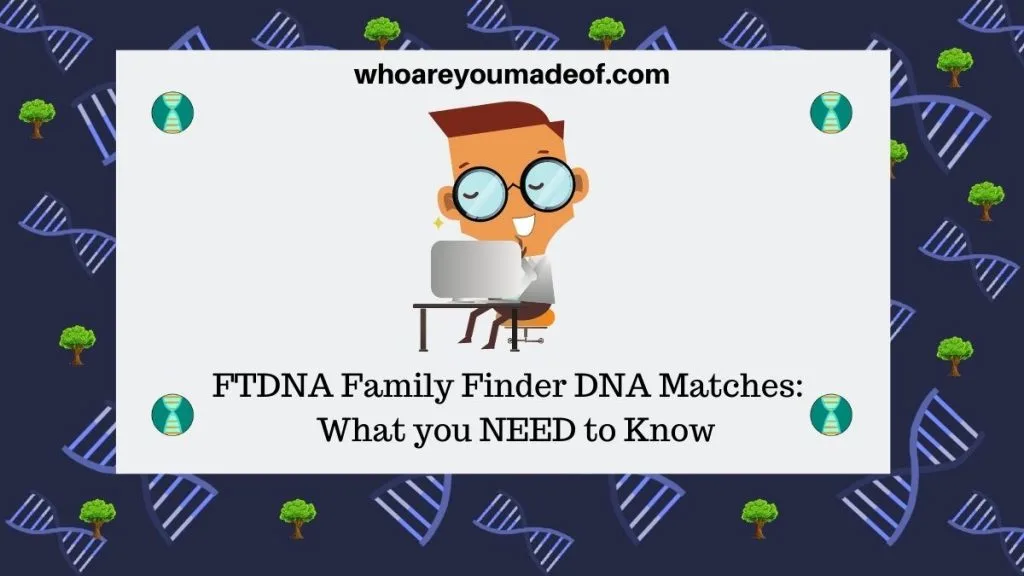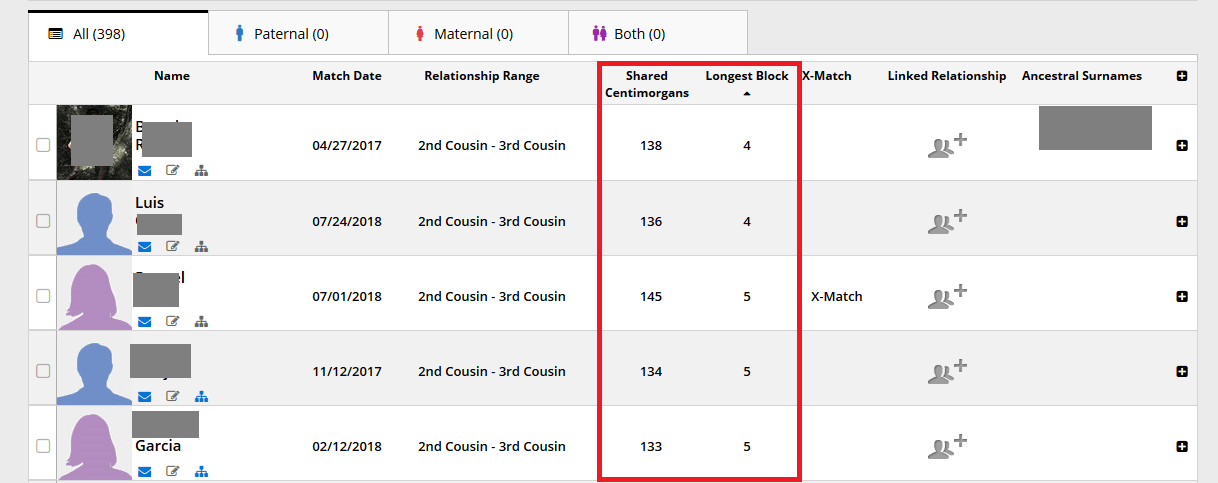If you did your DNA test with Family Tree DNA, you might have some questions about your DNA match list. We all want to figure out how our DNA matches are related to us and there is a lot of information that, when interpreted correctly, can help us do just that.

In this post, you’ll learn how to understand your FTDNA Family Finder DNA matches.
For the duration of this post, I will occasionally use “FTDNA” as an abbreviation, instead of the full name of the company: “Family Tree DNA”. You will find that this is a common way to abbreviate the site in discussion groups and on social media, and even on the website itself.
The Relationship Range is just an estimate
Family Tree DNA uses the amount of DNA that you share with your DNA match to determine an estimated relationship, which will always be reported as a range – no matter the relationship. For example, your child might appear as “Mother/Daughter”, or your second cousin might show up in the “1st cousin – 3rd cousin” category.
Why can’t FTDNA be more specific as to which relationship might apply between you and your match? I know… it would be amazing if we could just look our DNA match list and have the website tell us exactly how we are related to everyone without having to look through a family tree. What fun would that be, though?
The reason that FTDNA gives us a relationship range and not an exact relationship is because for each relationship, there is an overlap of shared DNA with other relationships. What do I mean by this?
- A parent shares about 3400 cMs (centimorgans) with their child, but a child also shares this with their parent. This means that a DNA match sharing 3400 cMs could be either a parent or a child, so both parent and child are listed as poss
- If you share 1300 cMs with a female match, for example, the match could be your half-sibling, aunt, niece, or even a grandmother, as well as a few other relationship types.
- If you share 75 cMs with a match, they could be a half-second cousin once-removed, or a 5th cousin, or anywhere in between, or (in rare cases) more distant than a 5th cousin.
As you might have noticed, the more distant the relationship, the more variety of relationship possibilities. This means that the more closely you are related to someone, the more DNA you will share, and the easier it will be to figure out how you are related. The only way to figure out your exact relationship is by comparing your family tree with your match’s family tree in order to find the most recent common ancestor (MRCA), using the total amount of shared DNA and the size of the longest segment as a guide.
Learn more about shared DNA, centimorgans, and estimated relationships in my post, “The Beginner’s Guide to Shared Centimorgans.”
Shared centimorgans are the key to your FTDNA list – but there’s a catch
As I mentioned, the total amount of DNA that you share with your match is going to provide the best clue as to how you are related, but there is something important that you should understand about the way that Family Tree DNA reports shared centimorgans.
The first thing to know is that the total number of shared centimorgans is comprised of DNA segments of varying length. It’s possible to share only one DNA segment with a match, or a few dozen. Each DNA segment is measured by “centimorgans”.
A few fun and relevant facts about DNA segments:
- Generally speaking, the larger the DNA segment, the closer the relationship
- Smaller segments usually indicate a more distant relationship
- The smaller the DNA segment, the higher the chance that the segment is coincidentally identical (identical-by-state)
Because smaller segments have a higher chance of being identical-by-state, or coincidentally identical, DNA testing companies generally have a cut-off threshold that they use to determine whether or not they will count a DNA segment towards the total amount of shared DNA. For example, if the threshold is 6 cM, this means that they won’t count any matching DNA segments smaller than 6 cM in the total amount of shared DNA.
Who does Family Tree DNA count as a match?
When Family Tree DNA compares your DNA to the DNA of other FTDNA members, they use a proprietary matching algorithm in order to determine a genetic match. For most people, FTDNA will only report a match if one of two conditions are met:
- There must be a DNA segment of at least 9 cMs in length, or
- The total amount of shared DNA must equal more than 20 cMs if the largest shared DNA segment only is 7.69 cMs
FTDNA seems to include very small segments (as small as 1-2 cM) in the total amount of shared DNA between matches. For example, if you share one 12 cM segment, a 3 cM segment, and two 1.5 cM segments, FTDNA will report a total shared centimorgan total as 18 cMs. It’s true that most of these segments will be coincidentally identical (IBS), but some of them could very well be legitimate segments inherited from a common ancestor. I think it is great that FTDNA includes these segments, since it gives us the ability to examine the data and determine whether it is important or not.
People from endogamous populations – watch out for tiny segments and large total shared DNA
Note: An endogamous population is a group of people, sometimes a very large group, who are descended from members of communities who intermarried for many generations. Some examples of endogamous populations are French Canadians, Native Americans (including people from Latin America, such as Mexico), Ashkenazi Jewsish people, and individuals descended from immigrants to the US during colonial times.
A small percentage of FTDNA testers, especially those who have substantial ancestry from an endogamous population, might find themselves looking at a list of many DNA matches that show a large number of shared centimorgans but a very small largest segment. Take a look at the following image:

If we take the top match as an example, we can see that this person shares 138 total centimorgans with the test taker, which could suggest that they are 2nd-3rd cousins. At a closer look, we notice that the longest DNA segment is only 4 cMs long. Most DNA segments that are this small will be “false”, or IDB (coincidentally identical). Since the total amount of shared DNA is so high (138 cMs) and the DNA match comes from the same endogamous population as the test taker, it is conceivable that some (even many) of the dozens of tiny segments that FTDNA reported could very well be from many common ancestors many, many generations ago – much too far back to be of genealogical use.
In other words, the test taker is absolutely not a second or third cousin to the match, even though the total number of shared centimorgans falls within the range of second-third cousins. If they are related, it’s probably very distantly, and there is a chance that they aren’t related at all.
This is a great example of why it is very important to pay close attention to the size of the largest DNA segment along with the total amount of shared DNA when trying to determine how far back in your tree to look for a MRCA.
Don’t miss these features of your Family Tree DNA match list
There are a few other aspects of your DNA match list that not everyone notices:
- If the little family tree icon is blue next to your DNA match, then this means that your DNA match has a family tree on the site. Check it out! It might be the clue that you need to determine your relationship or to learn something about your ancestry
- You can sort your list in all sorts of ways (get it?), and I wrote about them in my post “Cool Sorting Tricks for Family Tree DNA Matches“
- If you want to, you can view your match in the chromosome browser. Do this by “ticking” the box next to their name, and then clicking “Chromosome Browser” at the top of the match list. A new tab will open with the chromosome browser, and you’ll be able to see exactly which DNA segments you share with your match, how big they are, and where they are located on your chromosomes
Conclusion
I hope that you enjoyed this post and that you learn something new or interesting about your DNA matches. If you have any questions about something that you read in this post, or you would like to share something cool that you know about the way your Family Tree DNA match list works, I would love to hear from you in the comments.
Thanks for stopping by today!
